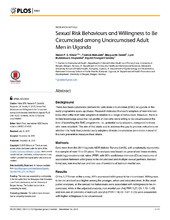| dc.contributor.author | Kibira, Simon Peter | en_US |
| dc.contributor.author | Makumbi, Fredrick Edward | en_US |
| dc.contributor.author | Daniel, Marguerite | en_US |
| dc.contributor.author | Atuyambe, Lynn Muhimbuura | en_US |
| dc.contributor.author | Sandøy, Ingvild Fossgard | en_US |
| dc.date.accessioned | 2018-01-03T08:02:15Z | |
| dc.date.available | 2018-01-03T08:02:15Z | |
| dc.date.issued | 2015-12-14 | |
| dc.identifier.issn | 1932-6203 | |
| dc.identifier.uri | https://hdl.handle.net/1956/17104 | |
| dc.description.abstract | Background: There has been substantial demand for safe male circumcision (SMC) in Uganda in the early programme scale-up phase. Research indicates that early adopters of new interventions often differ from later adopters in relation to a range of behaviours. However, there is limited knowledge about the risk profile of men who were willing to be circumcised at the time of launching the SMC programme, i.e., potential early adopters, compared to those who were reluctant. The aim of this study was to address this gap to provide indications on whether it is likely that potential early adopters of male circumcision were more in need of this new prevention measure than others. Methods: Data were from the 2011 Uganda AIDS Indictor Survey (UAIS), with a nationally representative sample of men 15 to 59 years. The analysis was based on generalized linear models, obtaining prevalence risk ratios (PRR) with 95% confidence intervals (CI) as measures of association between willingness to be circumcised and multiple sexual partners, transactional sex, non-marital sex and non-use of condoms at last non-marital sex. Results: Of the 5,776 men in the survey, 44% expressed willingness to be circumcised. Willingness to be circumcised was higher among the younger, urban and educated men. In the unadjusted analyses, all the sexual risk behaviours were associated with willingness to be circumcised, while in the adjusted analysis, non-marital sex (Adj PRR 1.27; CI: 1.16–1.40) and non-use of condoms at last such sex (Adj PRR 1.18; CI: 1.07–1.29) were associated with higher willingness to be circumcised. Conclusion: Willingness to be circumcised was relatively high at the launch of the SMC programme and was more common among uncircumcised men reporting sexual risk behaviours. This indicates that the early adopters of SMC were likely to be in particular need of such additional HIV protective measures. | en_US |
| dc.language.iso | eng | eng |
| dc.publisher | PLOS | eng |
| dc.relation.ispartof | <a href="http://hdl.handle.net/1956/17107" target="_blank">Male circumcision, sexual risk behaviour and HIV infection in Uganda. A mixed methods study among men age 15-59 years</a> | |
| dc.rights | Attribution CC BY | eng |
| dc.rights.uri | http://creativecommons.org/licenses/by/4.0 | eng |
| dc.title | Sexual Risk Behaviours and Willingness to Be Circumcised among Uncircumcised Adult Men in Uganda | en_US |
| dc.type | Peer reviewed | |
| dc.type | Journal article | |
| dc.description.version | publishedVersion | en_US |
| dc.rights.holder | Copyright 2015 The Author(s) | |
| dc.source.articlenumber | e0144843 | |
| dc.identifier.doi | https://doi.org/10.1371/journal.pone.0144843 | |
| dc.identifier.cristin | 1300721 | |
| dc.source.journal | PLoS ONE | |
| dc.source.40 | 10 | |
| dc.source.14 | 12 | |

